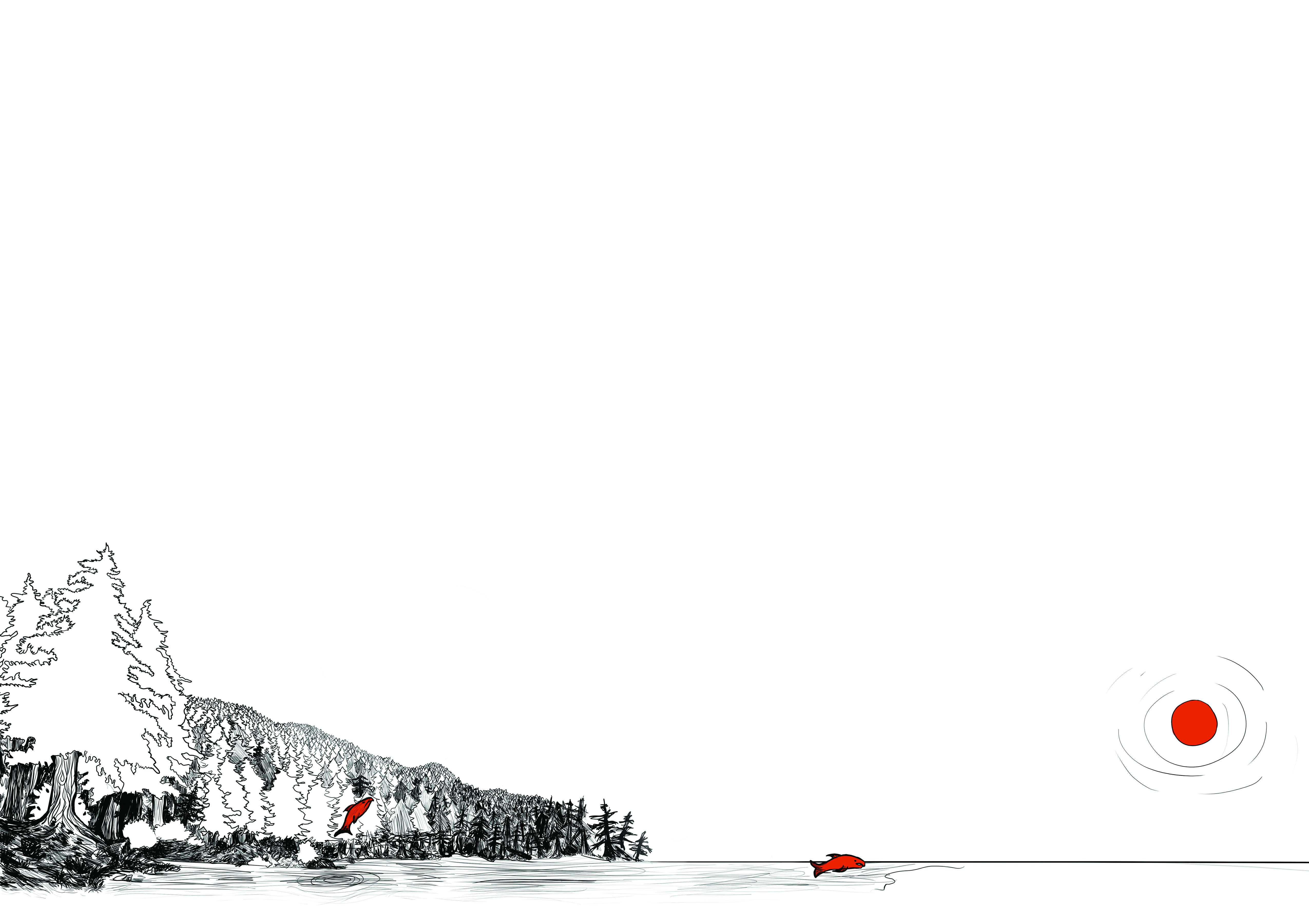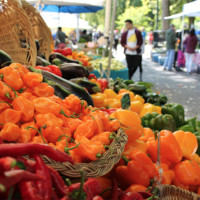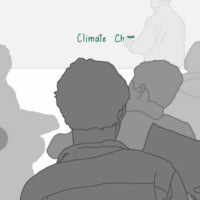
Only a week after Hurricane Harvey hit Texas and two weeks before Hurricane Maria hit Puerto Rico, Portlanders woke up to a layer of ash coating the ground. The hazy sky darkened the city, despite it being early September.
On Sept. 5, 2017, Portland Public Schools let students out two hours early due to excessive heat and diminished air quality as a result of forest fires. These fires, widely known as the Eagle Creek fires, were started when a teenage boy threw fireworks into the Eagle Creek Canyon. One-hundred and fifty-three hikers were stranded in the Columbia River Gorge area and forced to stay there overnight before their rescue. The fires were exacerbated by climate change, which made it more susceptible to burn.
A year later, massive fires in both California and Canada once again enveloped the Pacific Northwest in smoke and haze. “It felt like there was an apocalypse happening,” says Nicholas Caleb, staff attorney at the Center for Sustainable Economy. Caleb, who lived in Klamath Falls during this time, describes not being able to see more than 20 feet ahead of him because of thick smoke.
“Even if you had a mask it was still terrible, so I was indoors for the better part of three months with (an) air purifier and air conditioner and wasn’t leaving for anything except basic necessities,” Caleb says. “(It) started to wear on me really heavily after just a short time.”
Paul Loikith, Assistant Professor of Geography and Climate Science Lab Director at Portland State University (PSU), describes how higher temperatures during the winter led to reduced snowpack, as rain becomes more common than snow. This situation, combined with extreme heat in the summer, has led to drier forests.
“With summers being hotter, in particular, the atmosphere just is thirstier, it can evaporate more water so trees and plants can dry out more quickly. So, in some places you may see forests ending up drier than they used to be earlier in the year,” says Loikith.
While fires may be the most immediate effect of climate change for Portlanders, other human-made disasters have impacted the Pacific Northwest.
On June 3, 2016, 16 of 96 cars carrying Bakken crude oil derailed near Mosier, Ore.. This resulted in 42,000 gallons of spilled oil, most of which entered the Columbia River. The derailed train caught on fire and could not be extinguished for 14 hours, according to Friends of the Columbia Gorge.
While no one was killed or injured, the ecosystem surrounding the Columbia River Gorge was covered with toxic smoke, ash and oil.
Fossil fuels, which are the primary global source of energy, are often carried through the Pacific Northwest by train before being exported overseas. In 2016, 76 percent of the United States’ greenhouse gas emissions came from the burning of fossil fuels, according to the U.S. Energy Information Administration.
Zenith Energy, a Houston-based energy company, currently transfers crude oil from rail cars to ships at its terminal in Northwest Portland’s industrial area.
Because of the Pacific Northwest’s close proximity to the coast and direct boat access to Asia, it is a convenient place for the storage and transportation of fossil fuels. It takes nearly 22 days for oil to be shipped from the Gulf of Mexico to Asia, while it takes nine days to ship from the Pacific Northwest to Asia, according to Dineen O’Rourke, a campaign organizer for the climate-focused non-profit 350 PDX.
“This means that projects like Zenith are affecting the world as a whole,” says O’Rourke.
In an effort to lessen the worldwide effects of fossil fuels, the Oregon Legislature set goals in 2007 for the reduction of greenhouse gasses. The Oregon Global Warming Commission is responsible for updating the state government on the progress of those goals. But Lesley Jantarasami, a Senior Climate Policy Analyst for the Oregon Department of Energy and the lead staff member to the Commission, says, “we are not on track to meeting our goals.”
The New York Times and the Guardian have reported Portland and the greater Pacific Northwest as safer or preferable to other places in the world as the climate continues to change. However, Jantarasami says that more needs to be done in Oregon to address the causes of climate change. “(We) also (need) to prepare and adapt and create resilience,” she says.
Salmon
The Columbia River Basin was once the home of the most abundant salmon populations in the world. But since the 1980s, salmon have experienced a drastic decline due to overfishing, habitat loss and pollution, among other factors. According to the Environmental Protection Agency (EPA), there was a 64 percent reduction in the population of Chinook salmon between 1984 and 2010. Now, 13 species are listed as endangered, and several are extinct.
On Aug. 26, 2019, in the William K. Nakamura United States Court House in Seattle, Wash., the United States Court of Appeals for the Ninth Circuit heard arguments in the case of Columbia Riverkeeper v.
Andrew Wheeler, an administrator of the EPA.
This lawsuit, introduced by the Columbia Riverkeeper — a nonprofit founded in 1989 — worked to protect the water of the Columbia River. The lawsuit resulted from record-high water temperatures in past summers, which led to the deaths of around 250,000 adult sockeye salmon in 2015.
This is not the first lawsuit brought against the EPA by the Columbia Riverkeeper. In 2018, a federal district court ruled that the EPA had violated the Clean Water Act of 1972 by failing to produce a plan to keep water temperatures below 68 degrees Fahrenheit.
According to the Columbia Riverkeeper’s argument, salmon, which are suited to cold water, become vulnerable as temperatures rise, especially once the water temperature exceeds 68 degrees Fahrenheit. If the water temperature rises another five degrees, salmon migrations will stop altogether. Salmon that stay in warm water are more susceptible to disease, death and decreased spawning productivity. The implications of this are widespread and complicated.
A statement from the Wild Salmon Center says, “Salmon are the key to protecting a way of life rooted in the North Pacific environment: protect salmon and you protect forests, food, water, communities and economics.”
However, the Wild Salmon Center says that not enough is being done to protect salmon. “Most salmon
restoration efforts have failed so far because they were implemented only after salmon stocks reached low levels of abundance.” The Endangered Species Act of 1973 only stopped the harvest of coho salmon in Oregon after the population dropped below three percent of their historic abundance.
A July 2019 press release from the U.S. Forest Service that as dams and levees have changed the way that watersheds function, and are having a profound effect on salmon populations. This, combined with the impacts of climate change and warming water temperatures, will put increased pressure on the life stages and survival ability of salmon in the coming years.
From Alaska to the Columbia River to the Atlantic Ocean, salmon are dying because of warmer water. Large salmon die-offs prevent important nutrients from entering the ecosystems that they live in. In an interview with the Seattle Times, David Montgomery, a professor at University of Washington, says, “Fully one-third of the nitrogen in those big old-growth trees in our forests swam up river as a fish. When you lose those big runs of salmon you lose those nutrients, and it cascades through the whole system.”
Trees
In many urban settings, it takes a concerted effort from the residents to maintain a growing tree canopy. As weather patterns in Portland become more extreme due to climate change, certain trees will struggle to survive, according to Michelle Yasutake, a Neighborhood Tree Specialist with Friends of Trees.
“Trees in cities are great for a number of reasons … Cities invest in trees (because) they keep stormwater out of the storm drains, they keep the storm drains from overflowing,” says Yasutake. “Trees are also just great for so many aspects of human health, from mental health to a lot of different physical attributes as well — (having trees) cleans the air, it provides better air for people to breathe.”
Some neighborhoods in Portland can experience temperatures up to 20 degrees warmer than other neighborhoods due to their lack of vegetation. Historically low-income and non-White areas that were redlined in the 1930s had fewer trees planted in them. The lack of trees causes these areas to experience higher temperatures, according to Vivek Shandas, a professor of Urban Studies and Planning at Portland State University and the research director at the University’s Institute for Sustainable Solutions. This effect is known as an urban heat island — concrete-absorbed heat that is hotter than more vegetated areas. Urban heat islands typically use more energy in air conditioning than areas with more trees and experience reduced air quality.
Hotter, drier summers and colder, wetter winters could cause certain trees that are currently abundant in the Portland area to struggle, according to Yasutake. “We’re trying to make conscious decisions with the trees that we’re offering, knowing that in 30 years the climate may look very different and a lot of the trees,” she says. One of these trees is the Western Red Cedar, which is sensitive to drought and dies without enough water. As the effects of climate change become more extreme, Yasutake recommends planting trees that are frost-resilient and able to survive in dry, hot weather.
While the tree canopy in Portland is incrementally increasing, the national tree cover declines by approximately 36 million trees per year, according to a study by David J. Nowak and Eric J. Greenfield. As climate change progresses, Portland’s tree canopy also runs the risk of experiencing a decline.
A decreased tree canopy is an indication of poorer city health overall. Trees produce oxygen and absorb carbon dioxide, which help to clean the city’s air. They also act as sponges for stormwater, decreasing the risk of flooding.
“The loss of our air filters would be a huge, huge hit in an urban setting,” says Yasutake. Without an abundance of trees, she says, “It’s a bleak future, honestly.”
Water
Although water demand in Portland is decreasing, Portland’s main water supply, Bull Run Reservoir, is not always able to accommodate the needs of the city.
The Portland Water Bureau (PWB) has observed a trend of increasing temperatures in the Bull Run Watershed since the early 1900s, according to Kavita Heyn, the Climate Science and Adaptation Manager at the PWB. “Despite year to year variability in temperature, this trend is a clear signal of climate warming over time,” says Heyn.
Summertime streamflows have also decreased over time, reducing the amount of water flowing into the reservoirs that contain Portland’s water supply.
These trends are expected to continue for the next several years. However, “because the water system relies on rainfall rather than just snow and has a secondary water supply. There is already some built-in climate resilience,” says Heyn.
Portland sources its water from the Columbia South Shore Well Field when Bull Run’s water supply is insufficient. “We have used this source multiple times since the 1980s for both summertime and winter emergency purposes,” says Heyn. She adds that PWB has “used it regularly in recent years due to extreme weather conditions in the Bull Run.” During warmer winters and summers with drier springs, PWB noticed a decline in the amount of water in the Bull Run reservoirs.
“In 2015 and 2018 we experienced water and weather conditions that were really extreme compared to our past experience, and that was a real wake-up call for us, it meant that … we had to pump more groundwater to serve our customers than we ever have had to in the past,” says Heyn. “Both of those years represent conditions that are likely to become more common in the future with a warmer climate.”




